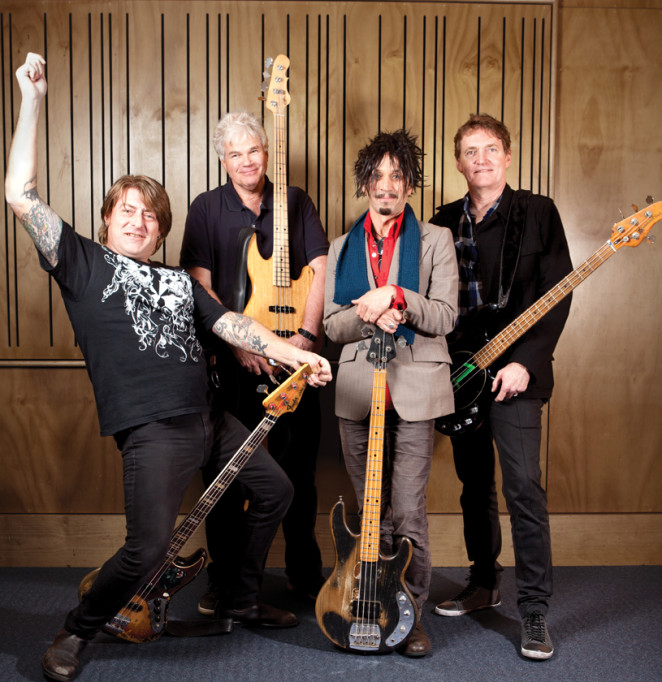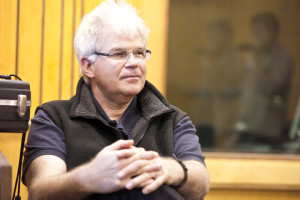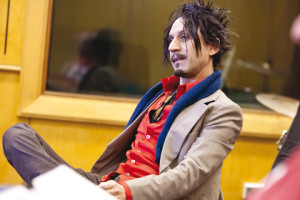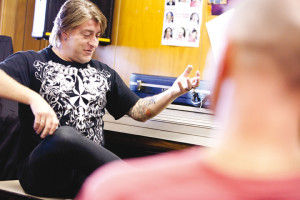BASS SUMMIT with
PAUL WOSEEN (Screaming Jets), Todd hunter (Dragon), STEVE BALBI (Noiseworks), IAN HULME (Choirboys)
June 1, 2011 | Author: Rob Morse. Photos: Ken Leanfore
Dragon, The Choirboys, Noiseworks and The Screaming Jets are undisputed icons of Australasian Rock. Their brands of driving music derive much of their power from the axis of rhythm and pitch – the bass guitar. So when the bassists from these four bands convened on a blustery May afternoon for a bass roundtable, Australian Musician’s Rob Morse was there to capture the moment. Todd Hunter, Ian Hulme, Steve Balbi and Paul Woseen sat down inside Bondi Pavilion’s historic Studio One, for a freewheeling discussion about all things bass related and much, much more.
After some extended introductory merriment, it was time to get down to bass business. The guys began by recollecting how they all originally came to the instrument.
TODD: In 1971 I was in a band that had two guitar players, no bass player, and a drummer. I was the crap guitar player, so I became the bass player and I loved it. Then I played lead on bass for six months, until the drummer said, “What are you doing? You know the bass plays down the bottom”.
STEVE: I never intended to keep playing bass, but we wrote some songs with Noiseworks and we had a hit. The next thing was I was the bass player. Now, I guess I don’t really consider myself a bass player anymore and I love playing bass
IAN: I was playing guitar, and then some mates had a gig at the Antler Hotel three nights a week and they needed a bass player.
PAUL: I played bass by default as well, in my first band, when I was fourteen. The bass player was such a better guitar player than me, so I said “This is stupid”. Then Nick and I swapped.
Amidst the recollections, the conversation predictably turned to the basses with which they had started out.
 IAN: Mine was a lovely white 70’s P bass.
IAN: Mine was a lovely white 70’s P bass.
PAUL: My first bass was a Fender Music Master, which I swapped a mid seventies Strat for. I’ve still got it too. I took the pickups out of a 73 P and put it into this little short scale thing and it just howled. The first bass I actually bought was an Emperador Precision copy. I took it apart twenty five years ago, sanded it all back and hand painted paisley everywhere, then lacquered it up just with house lacquer. I’ve never put it back together, but I’ll always keep the bits.
TODD: My old man got me a Paul McCartney Hofner, with a little piece of paper saying “I love this bass. I hope you have fun. Paul”. God knows where it went. I just thought “This bass is unmanageable”. (Imitates a short sustain, flatwound tone).
STEVE: I used to have a Framus, when I was playing with Kevin Borich, this upright stick.The first concert I ever went to, the guy was using this bass. It was Johnny Devlin And The Devils, and I went and bought it from their bassist. It was a bitch to play, but it had a nice tone. I used it through Noiseworks too. I was walking through Newtown about a year ago, and it was in a hock shop for twenty times more than what I sold it for, with a sign “Buy a piece of Australian history”.
Interestingly, once firmly ensconced in their respective bass chairs, all four were quickly seduced by the freedom and authority of their new roles.
STEVE: It’s a beautiful instrument, when you find out that you can take it easy and stop playing guitar all day. It’s a nice thing when you discover the simplicity of it and how hard it is to actually be simple.
TODD: The bass is the key to the band.
PAUL: When you start playing it just feels really good.
IAN: Yeah, it’s kinda like that. You go, “Hang on a minute, this feels right”, whereas the guitar never felt right to me. Not that I knew it. But then you go “It’s working!”.
STEVE: What I love now, is trying to find that harmonic thing. Just that note, off the root, that can just change the whole spectrum of the song. God it’s nice when you find one of those. It’s beautiful. Its such a powerful instrument like that.
TODD: I’ve been doing that quite a bit. Someone’s playing a D chord and I’ll just play a B. It completely makes this whole dark thing happen. The other thing that I’ve been doing is just stopping for a whole section. Its huge when you come back in, it’s massive.
STEVE: It feels very powerful sometimes, doesn’t it? Just that one note.
The guys also had some great anecdotes about some of the basses they have loved, loathed and lost.

TODD: Early on I had Gibsons, weird basses, until when we signed with CBS. They took us to the Fender warehouse and just said “Okay guys, go mad”, so I got a Precison bass. One night at the Tiger Lounge in Melbourne, I got so upset at the drummer, that at the end of the night I actually picked the bass up and threw it at his head. It missed him and sailed over the partition and into the urinal, just behind it. I was so furious. After a while the band thought I should go and get the bass. It was lying in the actual trough and people were standing on it. From that day on it was the most beautiful guitar. Years later, I had a really light Fender Jazz, which was great. But in the end, it just wasn’t big enough to play in the band, so I got a G&L. I hadn’t even heard it before I walked in the music shop. I felt like an ignoramus.
PAUL: That’s how I got my red G&L, the mahogany one. Karl, from The Bass Player, just comes up to me and says “Have you tried these before? Do you like it?”. He ended up giving me an endorsement. I’ve tried other brands and they just don’t seem fundamentally right, even their aesthetics.
TODD: I had a Steinberg for a while and then after a year or so I thought maybe I should just play a bass guitar, rather than a stick of carbon!
STEVE: Yeah, I bought one of those too. We played studio cricket with it.
IAN: I had a Kubicki Factor for a while, which was like the Steinbergs.
PAUL: They had the Hipshot built in…
IAN: Yeah, built in to the back of the head stock, well no head stock really, and the tuners down the wrong end.

STEVE: I’ve lost a few basses, but I remember having a nice EB3. That was a beautiful guitar, sort of an SG, with the acoustic guitar headstock.
IAN: I had a Ripper once, they were good. I swapped it for a Telecaster copy guitar, when they were worth nothing. I regret it.
TODD: I’ve just got a Harmony E55. It’s a complete remake, with the golf ball pick up. It’s so light, you pick it up and there’s nothing to it. I also bought a Samick bass for one of my kids and it’s the most fantastic dub bass. Really nice.
STEVE: I had an Alembic for a while. Don from Mi-sex had one. I saw and heard it at a gig once and I thought “I must get one of those”. They looked pretty cool at the time, didn’t they?
IAN: They were almost revolutionary.
STEVE: Yeah, and very even. I forget why I stopped liking it, maybe it was too even, maybe not woody enough.
IAN: Yeah, I’ve been through that. I’ve had a couple of basses where it’s been so perfectly even in the studio, it sounds great. But then I pick up the old Stingray and one string sounds different to the other. But it just works like that. It’s good that the E string sounds that way and it’s good that the A string sounds a particular way.
TODD: The Stingray just kills your back, shoulder, everything. It’s so heavy.
IAN: I’ve got a dicky shoulder. I can’t lift my arm far. Stingray shoulder.
TODD: I played the Stingray for ten years and my whole left shoulder is gone.
STEVE: I’ve got one of them too. The shoulder and the Stingray.
PAUL: I just took my Stingray to James Cargill down in Melbourne, and he went over it for me. I love it, but it’s like fourteen kilos.
IAN: Someone needs to hollow it out or something.
TODD: I’m the only loser that’s sold his damn Stingray!

PAUL: Yeah, I couldn’t get rid of this. It’s a cracker.
STEVE: I bought mine when they first came out and its the only bass I can use with Noiseworks. I’ve got a Fender Jazz and I took that when we started doing some shows again, a few years back. It’s my preferred bass, but it doesn’t sound right in the band. So I’ve got the old road case and when Noiseworks plays, I take the Stingray. That’s all it does, I don’t even use it in the studio. It’s just part of the sonic of that band.
PAUL: I had twenty seven basses at one stage, but then I decided that I needed to eat!
Although Todd, Ian, Steve and Paul were all staunch proponents of Leo Fender’s bass designs, they had some radically divergent ideas when it came to amplification.

IAN: I’ve never had an effect that sounds as good as just the bass into a nice valve amp, with those overtones ringing through.
TODD: Yeah, just an SVT.
PAUL: I’ve been trying to buy one of those little grey Gallien Krueger 800s. I ran Ampeg SVT IIs and big eight by tens for years, but I could never duplicate my studio sound with that. The room, or the heat, always played a part in the actual sound. With the GK, it’s got no sort of real character about it, which I really like. It just sounds consistent, everywhere I go.
TODD: That’s what you get from SVTs, that big, boofy, warm and fuzzy sound.
PAUL: But it’s become so much mush. I don’t know whether it’s my hearing, or if its just how I like to hear it, but I have to dial in a lot of 300k, just so I can hear my notes. I’m playing with my fingers and I’ve got sound guys hassling me about that. The GK seems to have this nose to it that just sort of pokes through. I’ve also been trying to get Harry Brus to sell me one of his Alembic preamps, but he won’t do it.
TODD: I haven’t had an amp in thirty years, at all. Marc just kept throwing chairs at me because it was so loud, so I said “No amplifier whatsoever”, and its been great from there on. Now I’ve just got an SVT pedal. Even when I’ve got an SVT speaker cabinet, I use it. The SVT pedal on the SVT. It’s really scoops it all out. There’s a lot less mush on stage, although with big shows you always play through an amp, because otherwise it’s too weedy.
As both touring and recording artists, the bassists were well positioned to compare these two very different low end disciplines.
STEVE: I remember when I worked with a producer years ago and coming from the Borich thing, I used to be proud of having metal hands. I played really hard. It was Randy Jackson who actually produced the track. He said “Do you hit hard, or do you play soft?”. And I said “I hit hard mate, really hard”. And he’s going “Oh bummer”. Now I find when I’m in the studio, that the softer touch seems to create the best tones out of the bass.
TODD: Live, you just have to play as hard as you possibly can, to get the whole crowd going up and down. Studio stuff, if you dig in too much, it kills it a bit.
PAUL: I do a lot more moving in the studio, from up the neck right down to the bridge, than I do live. Live its pretty much here (indicates directly over pickups), where my thumb has worn the wood away.
GEAR BOX
Todd Hunter:
• G&L JB2, with retrofitted preamp
• Fender Precision
• 1964 Burns Bison
• Reissue Harmony H55
• Michael Kelly acoustic bass
• Bohemian double bass
• Samick short scale bass
• Ampeg SVT preamp pedal (straight into the PA, for smaller shows)
• Ampeg SVT Classic with 8 X 10 cabinet (when backline supplied, for larger gigs)
Ian Hulme:
• Musicman Stingray
• Mesa Boogie Bass 400+
• Trace Elliot cabinet, retrofitted with Cerwin Vega 10” speakers
Steve Balbi:
• Musicman Stingray
• Fender Jazz
• Ampeg Classic
Paul Woseen:
• Gallien Krueger, Ampeg and Labsystems amplification
• Musicman, G&L and Fender basses


